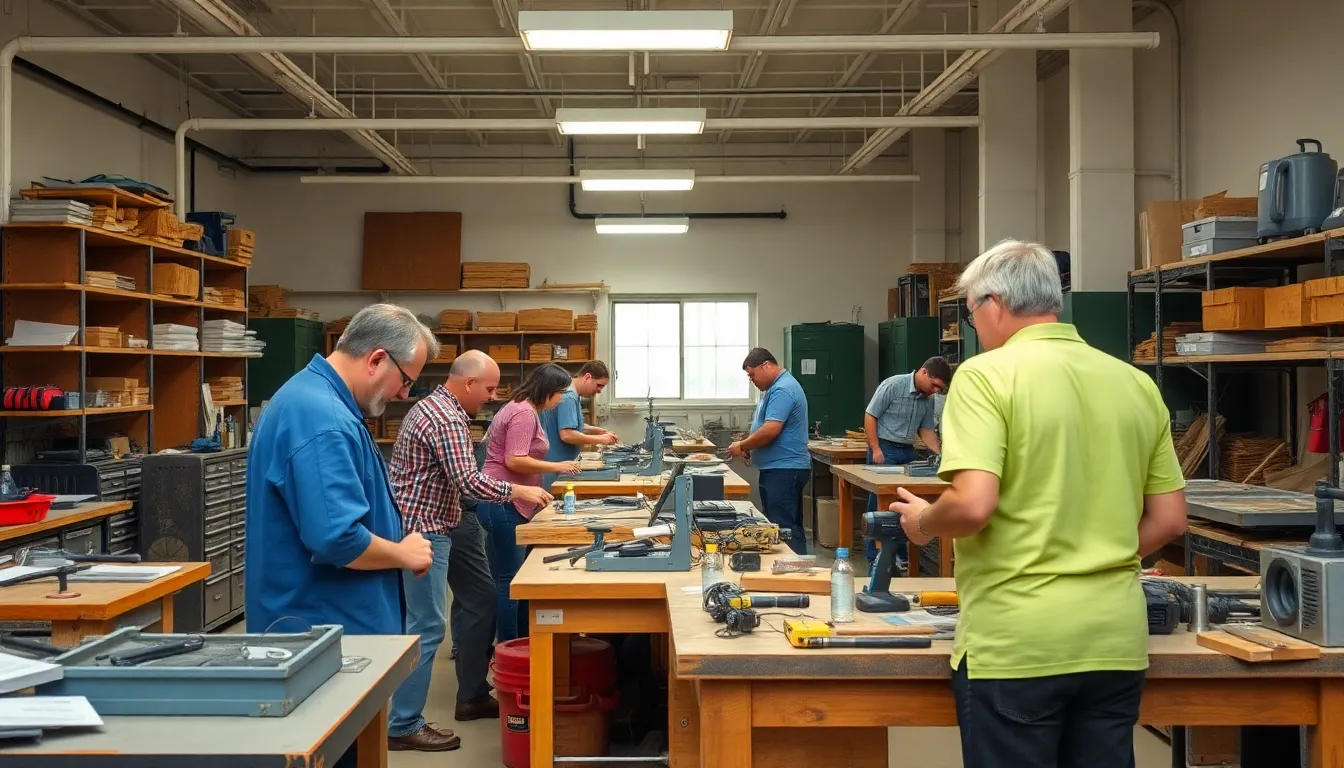Imagine walking into a workshop where every tool is within arm’s reach, and chaos is just a myth. Tool-friendly workshop design isn’t just about aesthetics; it’s about creating a space that sparks creativity and boosts productivity. With the right layout and organization, even the most daunting projects become a breeze.
Table of Contents
ToggleWhat Is Tool-Friendly Workshop Design?
Tool-friendly workshop design refers to creating a workspace that maximizes efficiency and accessibility for tools and materials. This design focuses on organizing tools in a manner that promotes easy access during various tasks. Prioritizing layout enables individuals to work without unnecessary interruptions.
Efficient placement of tools increases productivity. Positioning frequently used tools within arm’s reach reduces the time spent searching for items. Clear labeling of storage areas enhances usability, allowing for quick identification of needed items.
Incorporating flexible workspaces encourages collaboration. Adaptable areas for group projects can accommodate different tools and materials while promoting creativity. Such environments support dynamic workflow and facilitate engaging collaboration among workshop users.
Safety plays a crucial role in tool-friendly designs. Implementing non-slip surfaces and providing adequate lighting minimizes the risk of accidents. Awareness of safety protocols ensures a secure environment where users can focus on their projects.
Workshops should also include areas for maintenance and repair. Designating a specific space for tool upkeep elevates functionality and prolongs the lifespan of equipment. Having dedicated maintenance areas instills a culture of care toward tools and materials.
Overall, tool-friendly workshop design fosters an organized, efficient, and safe atmosphere. This arrangement allows users to immerse themselves in their projects while maintaining a clear structure. Emphasizing functionality and accessibility leads to an enhanced workshop experience.
Key Principles of Tool-Friendly Workshop Design

An effective workshop design prioritizes accessibility and safety. Focusing on these aspects enhances usability for everyone involved.
Accessibility and Layout
Efficient layout promotes easy access to tools. Tools should remain within reach during any task. Observe the workflow to ensure a smooth flow across workstations. Place frequently used tools in accessible locations, reducing the time spent searching. Work surfaces need to accommodate various tasks while allowing mobility. Label storage areas clearly to assist in quick identification. Groups of similar tools benefit from centralized storage solutions. Flexible layouts, including adaptable workstations, support diverse project needs. Ultimately, a well-organized arrangement increases productivity and enhances creativity.
Safety Considerations
Safety remains paramount in workshop design. Non-slip surfaces significantly decrease accident risks. Proper lighting helps illuminate work areas, preventing injuries during complex tasks. Emergency exits and clear pathways provide safe evacuation during emergencies. Professional-grade ventilation systems minimize exposure to hazardous fumes and particles. Personal protective equipment storage ensures readiness for safety compliance. Regular inspections maintain equipment condition and highlight any potential safety issues. Collaboration areas should foster communication while prioritizing user safety. By incorporating these features, a workshop promotes a secure and focused environment for all users.
Benefits of Tool-Friendly Workshop Design
Tool-friendly workshop design significantly improves overall functionality and enhances the user experience, driving creativity and productivity in various projects.
Increased Efficiency
A well-organized workshop allows users to locate tools quickly. Efficiency increases when tools are easily accessible and maintained in an orderly manner. Proper placement of frequently used items reduces the time spent searching for them, thus streamlining workflows. Storage solutions like pegboards and labeled bins support swift organization. Users benefit from a layout designed for multitasking, where the placement of work surfaces accommodates similar activities. Minimizing distractions leads to faster task completion. Furthermore, dedicated spaces for maintenance ensure tools are always in peak condition. Studies suggest that organized environments can enhance focus by up to 30%, making efficient design vital for any workshop.
Enhanced Collaboration
Collaboration thrives in a workshop tailored for teamwork. Open layouts encourage interaction among users working on joint projects. Shared tool stations streamline access, fostering discussions around techniques and ideas. Arranging workspaces to promote group activities enhances communication and problem-solving abilities. Flexible areas can easily adapt to accommodate larger teams or solo projects as needed. Clear labeling facilitates swift tool identification, minimizing interruptions during collaborative tasks. Research indicates that teamwork in efficient environments can increase productivity by over 25%. Creating a space that supports collaboration ultimately leads to innovation and improved project outcomes.
Best Practices for Implementing Tool-Friendly Design
Implementing tool-friendly design involves careful consideration of space usage and organization strategies. By following best practices, workshops can thrive.
Space Planning
Effective space planning ensures accessibility and efficiency. Designers should create designated zones for different activities, allowing users to navigate seamlessly. Layouts that incorporate flexible workstations enhance collaboration, enabling groups to adapt to various tasks. Incorporating ample walking paths prevents congestion, promoting movement. Users benefit from arranging tools and materials within arm’s reach. Prioritizing proper lighting in all areas enhances visibility and safety. Thoughtful placement of equipment also supports ergonomic practices, reducing strain during use.
Tool Organization
Tool organization enhances usability and efficiency. Users should categorize tools by function and store them in clearly labeled sections. Pegboards and modular storage solutions facilitate quick access to frequently used items. Staff can employ color-coded labels to further simplify identification. Centralizing storage for similar tools promotes an orderly environment. Regularly evaluating storage solutions ensures they meet changing needs. Encouraging a clean workspace helps maintain focus and reduces distractions. Lastly, incorporating maintenance areas into the design helps keep tools in optimal condition and fosters responsible use.
A tool-friendly workshop design is essential for fostering creativity and productivity. By prioritizing organization and accessibility, users can easily navigate their space and focus on their projects. Safety features further enhance the environment, promoting a secure atmosphere for all activities.
Implementing best practices in layout and tool management not only streamlines workflows but also encourages collaboration among users. Regular maintenance and evaluation of the workspace ensure it remains functional and efficient. Ultimately, a well-designed workshop empowers individuals to engage fully in their craft while maintaining a structured and enjoyable experience.


